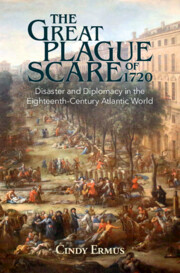Refine search
Actions for selected content:
5 results
5 - Entangled Empires
-
- Book:
- The Great Plague Scare of 1720
- Published online:
- 11 November 2022
- Print publication:
- 01 December 2022, pp 177-213
-
- Chapter
- Export citation
1 - Plague in Provence
-
- Book:
- The Great Plague Scare of 1720
- Published online:
- 11 November 2022
- Print publication:
- 01 December 2022, pp 13-64
-
- Chapter
- Export citation
Epilogue
-
- Book:
- The Great Plague Scare of 1720
- Published online:
- 11 November 2022
- Print publication:
- 01 December 2022, pp 214-219
-
- Chapter
- Export citation
Introduction
-
- Book:
- The Great Plague Scare of 1720
- Published online:
- 11 November 2022
- Print publication:
- 01 December 2022, pp 1-12
-
- Chapter
- Export citation

The Great Plague Scare of 1720
- Disaster and Diplomacy in the Eighteenth-Century Atlantic World
-
- Published online:
- 11 November 2022
- Print publication:
- 01 December 2022
